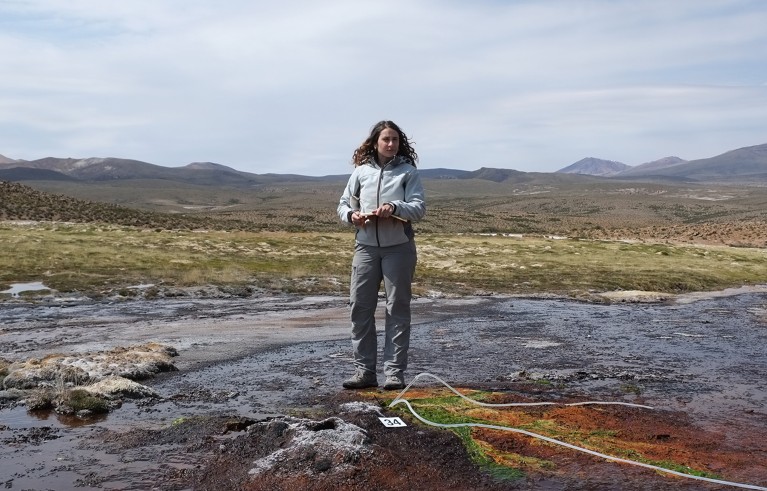In this photo, I'm collecting water samples from a geothermal seep at a site in the Chilean Andes. You can see a glass tube reaching into the seep’s mouth: it is used to sample water deep underground, that has not yet come into contact with the oxygen in the atmosphere.
Seeps like this one are deep-water upwelling points. Through fissures in the continental crust, the water trapped underground rises to the surface. We want to learn more about the chemical composition of this water and the life forms that inhabit it.
I am a PhD candidate working on CoEvolve, an ERC-funded project studying how the geosphere and the biosphere continuously influence each other. My research focuses on the interaction between tectonic processes that affect metal availability on the Earth's surface, and the ways these metals are used by microbial communities. Metals are crucial for the metabolism of microbes, which in turn help recycle elements that keep our planet inhabitable. Without plate tectonics and subduction processes, which continuously recycle elements and bring them to the surface, Earth would probably be sterile. Our research therefore starts on a very small scale — bacteria and their metabolism — but ultimately reflects on a much larger one: what makes a planet suitable for life.
For me, this area of research is a never-ending source of ideas. I have a background in natural sciences and having an interdisciplinary mindset, as well as a diverse team, is essential for studying how the Earth and life interact. During our 2022 expedition in the Chilean Andes, we collected samples from 38 sites. Each site must be studied as a whole, in terms of its microbiology, tectonic setting, water and sediment composition, and so on.
We focus on areas where there is secondary volcanic activity, that is a clue of the subduction processes taking place beneath. In microbiology, we generally study how environmental variables are influencing microbial communities by taking samples at distances of a few centimetres from one another. In the case of this research, however, we are analysing sites tens of kilometres apart, in order to reduce the noise coming from environmental variables on a small scale, and focus on how large-scale tectonic processes influence the geochemistry of our sites. And, as a result, microbial communities. During this expedition we followed the Andes, a mountain range that originated as a result of the subduction between an oceanic and a continental plate.
The fieldwork was exciting; these sites are breathtaking, dotted with colourful microbial mats -as seen in the photo. But it was also challenging because of the extreme altitude conditions we had to endure for weeks. The terrain is rough: I lost count of how many tyres we changed. At an altitude of 4,500 m above sea level, it becomes even more difficult to carry heavy instruments, sample cases and liquid nitrogen tanks needed to freeze the samples. You need to take it slow — something I am not used to.

